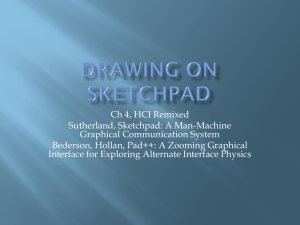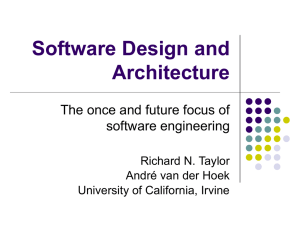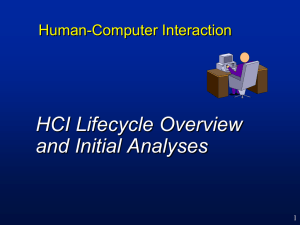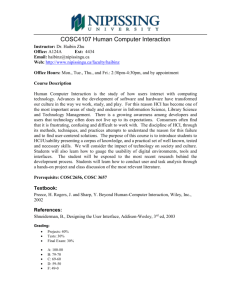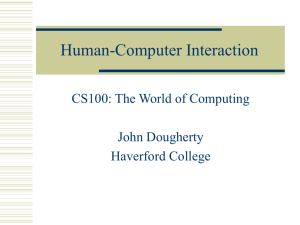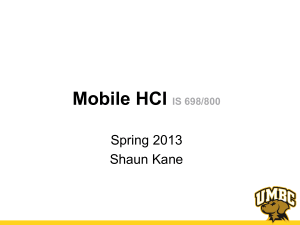DESIGN: DESCRIBING THE BLIND MEN’S ELEPHANT
advertisement
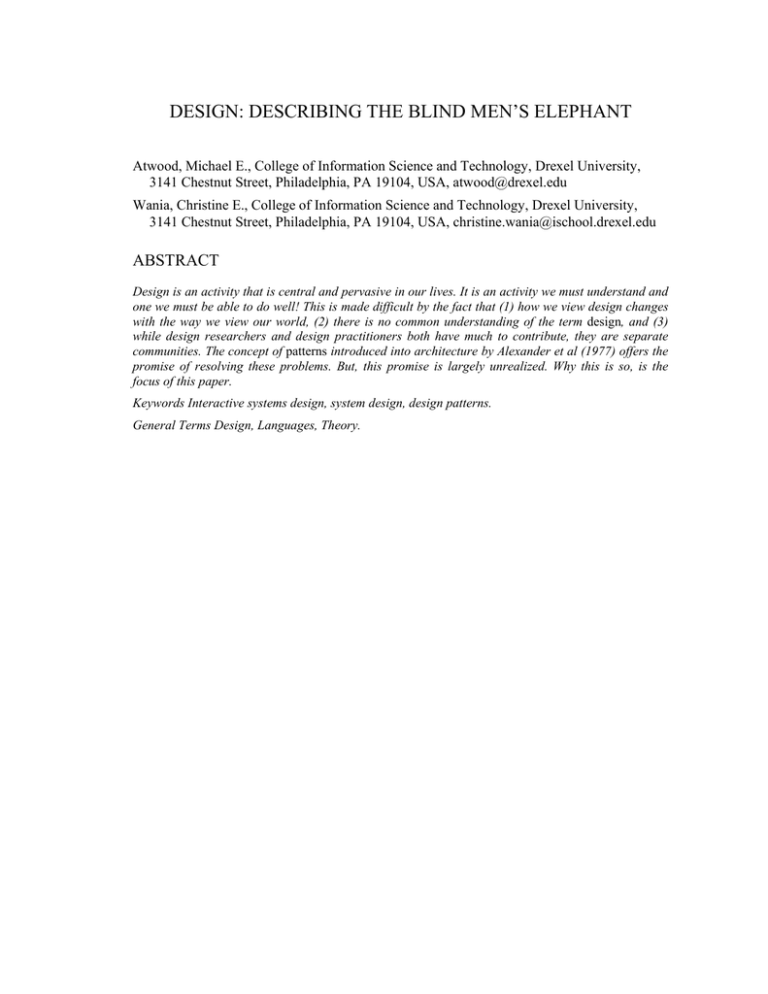
DESIGN: DESCRIBING THE BLIND MEN’S ELEPHANT Atwood, Michael E., College of Information Science and Technology, Drexel University, 3141 Chestnut Street, Philadelphia, PA 19104, USA, atwood@drexel.edu Wania, Christine E., College of Information Science and Technology, Drexel University, 3141 Chestnut Street, Philadelphia, PA 19104, USA, christine.wania@ischool.drexel.edu ABSTRACT Design is an activity that is central and pervasive in our lives. It is an activity we must understand and one we must be able to do well! This is made difficult by the fact that (1) how we view design changes with the way we view our world, (2) there is no common understanding of the term design, and (3) while design researchers and design practitioners both have much to contribute, they are separate communities. The concept of patterns introduced into architecture by Alexander et al (1977) offers the promise of resolving these problems. But, this promise is largely unrealized. Why this is so, is the focus of this paper. Keywords Interactive systems design, system design, design patterns. General Terms Design, Languages, Theory. 1 INTRODUCTION No human activity is more central to our lives, and more pervasive in its effects, than design. Every artifact we use, from apple peelers to airplanes, from staplers to software, results from a process of design. Whereas the natural sciences developed a scientific method as a common means of inquiry, for the artificial sciences and their related professions, design is the paramount skill. Yet our understanding of how to design and our methods of teaching and learning design remain piecemeal and ad-hoc. We, as a profession that holds design skill in high-esteem, do not have a common view of how to think about design. This is not to imply that we need a single view of design. Quite the contrary, we believe that a diversity of views is needed. But, we argue that a common understanding of how these diverse views relate is needed but currently missing. We begin with the following observations. First, how we view the world is changing and this will necessitate changes in the way we think about design. Second, the terms design and designer mean many different things to many different people; what some call design and what some see as the important aspects of design are not similarly seen by others. Third, in the broad realm of design, we have a disconnect between the research community and the practitioner community. The design of a complex artifact, for example a passenger plane, a cellular telephone, or a software application requires the skills of diverse designers—mechanical and electrical engineers (for the plane or telephone) as well as programmers and software engineers, interaction designers, anthropologists, and cognitive scientists. It is notoriously difficult for a diverse group of designers to communicate effectively. Each knows what is most important and each knows the best way to achieve their goal. Each often does not recognize the importance of the others’ goals, nor understand the others’ methods. Even within a given discipline, designers seldom share a common view of design. We must restructure the way that those of us in the artificial sciences think about design. The distinction between artificial and natural sciences was noted by Herbert Simon (1969) in the Karl Taylor Compton Lectures in 1968. Our prehistoric ancestors engaged in artificial sciences long before they engaged in physical sciences. Figuring out how to arrange tree branches to make a shelter, or how to select the best seeds to sow for the next harvest, or how to preserve an ember so that fire could be restored at a later time, were all design tasks. The artificial sciences underlying these problems were understood long before the natural sciences were even contemplated. In application, the artificial sciences are ancient, not new. In terms of formal definition, however, the natural sciences are much better established. For the past few centuries, the natural sciences have shared a common search to define a scientific method. Across domains, natural scientists agree on the proper way to investigate the properties of natural objects or phenomena. Such agreement is absent in the artificial sciences. Indeed, as Buchanan (2001) notes, there is even doubt that there is a significant body of design knowledge: “Despite a growing body of research and published results, there is uncertainty about the value of design research, the nature of design research, the institutional framework within which such research should be supported and evaluated, and who should conduct it. In short, there is uncertainty about whether there is such a thing as design knowledge that merits serious attention.” Individually, we know what design is. Within a discipline, these definitions merge into a fuzzy pattern. Across disciplines, one definition seems to have little connection with another. Our goal is to describe the challenges now facing designers, to describe current views of design, and to suggest how we might foster better communication and cooperation between these diverse views of design. We address these topics in the sections below. 2 A VERY BRIEF HISTORY OF THE DESIGN OF INTERACTIVE SYSTEMS People have practiced design for roughly 2.5 million years! As Mayall (1979) notes in Principles of Design, design, viewed as the creation of artifacts used to achieve some goal, traces back to the development of stone tools. Mayall notes that early design was driven by the belief that new is better and that technology is good and these stone tools were clearly better than what preceded them. That groups of people might work together, that the context of use might influence design, that people might have need for multiple tools at one time or might use one tool in multiple ways were not factors that needed serious consideration. This early approach to design sounds simple, and it was. For most of our history, knowledge of physical properties of materials and of principles of mechanics was sufficient to produce an artifact that met specifications. In the 1950s, things begin to change... Dreyfus (2003) was one of the first designers to focus on the fact that the goal of design was to fashion artifacts that people could use. He noted that “We bear in mind that the object being worked on is going to be ridden in, sat upon, looked at, talked into, activated, operated, or in some other way used by people individually or en masse.” Although a focus on people may sound commonplace today, it was revolutionary in the 1950s. By the 1960s, new technologies and new uses for systems had reached the point where it was becoming clear that something needed to change about the way we thought about design. Christopher Alexander (1964) acknowledges in Notes on the Synthesis of Form, that many design problems were reaching “insoluble levels of complexity.” Design problems that once looked simple and that had simple solutions now looked more complex and new, more formal approaches to design were proposed. By the 1980s widespread use of personal computers sparked tremendous interest in what would emerge as the human-computer interaction (HCI) community. This work was very much in what Bødker (2006) calls first wave HCI. Usability was the primary focus of both researchers and practitioners. And, usability was understood to involve one person interacting with one system to do one thing. In second wave HCI, which Bannon (1992) described as the move from human factors to human actors, the focus shifted to groups of people, typically in established communities of practice, working toward common goals but with a collection of applications. Communication and collaboration became key topics for research and practice. In Bødker’s (2006) third wave HCI, “the use context and application types are broadened, and intermixed, relative to the focus of the second wave on work. Technology spreads from the workplace to our homes and everyday lives and culture.” She continues to note three challenges – (1) people need to be involved in design, not just as workers, but as someone who brings their entire life experience into the design, (2) this will necessitate a change in the way we design and prototype, and (3) we need to move away from end-user programming in isolation to configurations involving multiple people and multiple systems. In summary, the broad design community recognizes that something needs to change in the way we design. With respect to interactive systems, we are clearly in third wave HCI and any changes must address these challenges. How these changes should be implemented depends on how we view design. 3 VIEWS OF DESIGN Historically, as our views of our world have broadened, so have our views of design. As our world focus has moved from usability to collaboration to context, so has our design focus changed. As we move into third wave HCI, how should we view design? 3.1 A Sampling of Definitions No single concise definition of design is universally accepted. Table 1 presents a sampling of definitions of design proposed by various authors. This list is adapted from Atwood et al (2002) who identified the most frequently cited authors who write about design. The Sciences of the Artificial (Simon, 1996), one of the most highly cited resources in the modern design literature offers, in many respects, an encompassing view of design. Simon concludes that in large part, “the proper study of mankind is the science of design, not only as the professional component of a technical education, but as a core discipline for every liberally educated person” (pg. 138). In Cognitive Work Analysis, Kim Vicente (1999) approaches the design of work support systems building on 30 years of Jen Rasmussen's research. Primarily concerned with task analysis, Cognitive Work Analysis advocates a holistic approach to design. The design of information systems should be based on an explicit analysis of work and used as a means to “derive implications for design” (Vincente, 1999, pg. 13). Herbert A. Simon J. Christopher Jones Christopher Alexander Horst Rittel Donald Schön Pelle Ehn Jens Rasmussen/Kim Vicente Table 1. …devising courses of action aimed at changing existing situations into preferred ones …initiating change in man-made things …the process of inventing physical things which display new physical order, organization, form, in response to function …structuring argumentation to solve “wicked” problems …a reflective conversation with the materials of a design situation ...a democratic and participatory process …creating complex sociotechnical systems that help workers adapt to the changing and uncertain demands of their job A sampling of definitions of design. Christopher Alexander, in Notes on the Synthesis of Form, (1964) shares with Simon, Rasmussen, and Vicente a focus on the environment. He addresses the problem of design complexity by focusing on the problem in its potential environment of use. Alexander first defines the ultimate object of design as form. Every design problem begins with an effort to achieve fitness between two entities, the form of the artifact to be designed and its context (1964, pg. 15). Horst Rittel, like Simon, notes that design problems are different from problems in the natural sciences. He refers to problems in natural science as tame or benign because the end mission is clear. Problems in natural science have a finishing point; one can tell when a solution has been found. Rittel terms problems in the artificial sciences as wicked problems, because they lack these clarifying traits. Like Simon’s Sciences of the Artificial, Schön’s (1983) The Reflective Practitioner, highly cited by writers in the design community, is at a theoretical level. Schön touches upon reflection-in-action as an elemental part of the design process. The reflective conversation takes place when the designer reflects-in-action on the “construction of the problem, their strategies of action or the model of the phenomena which were implicit in his moves” (1990, pg. 79). In Work-oriented Design of Computer Artifacts, Pelle Ehn (1989) notes that the design of systems to function in complex situations, such as large technology-oriented companies or interdisciplinary design domains, requires a deep understanding A central theme of Ehn’s approach to design is that users and developers must work closely together. Ehn’s approach is associated with the Scandinavian approach to design, or participatory design, as well as work-oriented design 3.2 Design as Religious War Design is a term that brings many people together. Conferences, publications, and professional societies are formed to support the design research community. These, and other venues, are also formed to support the design practitioner community. Collectively, we distinguish ourselves from others by the fact that we are designers. Design is a term that pushes people apart. Not everyone sees as design the new fashions in Milan’s boutiques. While some are impressed with the design of a new telephone, not everyone sees this as design. While we might collectively agree that interface design is different from interaction design is different from user experience design, we will not agree on which is the real design task. Design unites us, but design divides us. As a community, we believe it is important. But, as a community, we lack a common definition of what it is. Many views and several classifications of design have been proposed. For centuries, civilization has endured religious wars. Religious differences have been seen as legitimate reasons for one state to go to war against another. Do we have something parallel to religious wars in the broad design community? Looking at ACM, one of the major professional societies concerned with the design of interactive systems, we find 19 conferences with the word design in the title, and we assume they all have something to say about design. Clearly, there is a lot of interest in design! But, ACM represents a very broad range of interests. If we limit our search to conferences affiliated with SIGCHI, ACM’s special interest group most closely aligned with the design of interactive systems, we find 4 conferences with design in the title. DIS: Designing Interactive Systems, started in 1995; IDC: Interaction Design and Children, started in 2002; DUX: Designing for User Experience, started in 2003; and DPPI: Designing Pleasurable Products and Interfaces, also started in 2003. We note that these are not the only SIGCHI-affiliated conferences that include design as a topic. If we go even broader, which would be appropriate, and include groups such as AIGA (American Institute of Graphic Arts), the European Graphic Design conference, the European International Conference on Design Management, or the European Academy of Design Conference, which also deal with the design of interactive systems, the number of conferences, professional societies, and journals grows tremendously! We acknowledge that some people attend multiple conferences focused on design. But, they will have a stronger affiliation with one than with the others. We also acknowledge that the various conferences on design, as well as the various professional societies and journals, attract different audiences and cover different topics. But, that is exactly our point! Religious differences were seen as legitimate reasons for one state to go to war with another and differences about what is really important about design are seen as legitimate reasons to start another conference, journal, or professional society. The CHI conference did not focus adequately on design¸ so DIS was created! The DIS conference does not focus adequately on design, do DUX was created! Soon, we expect that it will be decided that neither CHI, nor DIS, nor DUX focuses adequately on design and yet another conference series will be created! As a broad community, we agree that design is important. What we lack is a common understanding of what design is. Clearly, we as a broad community, have different views. Collectively, we are fragmenting rather than uniting the design community. 3.3 Design as the Blind Men’s Elephant It was six men of Hindustan To learning much inclined, Who went to see the Elephant (Though all of them were blind) That each by observation Might satisfy the mind. (John Godfrey Saxe) In the parable of the blind men and the elephant, six scholars variously observe an elephant to be like a wall, a spear, a snake, a tree, a fan, and a rope. Saxe’s poem, The Blind Men and the Elephant, concludes with the verses below. And so these men of Hindustan Disputed loud and long, Each in his own opinion Exceeding stiff and strong, Though each was partly in the right And all were in the wrong. So oft in theologic wars, The disputants, I ween, Rail on in utter ignorance Of what each other mean, And prate about an Elephant Not one of them has seen! Saxe, writing in the 19th century, summarizes the broad design community quite well. There are many views and, following Saxe, we believe that each was partly in the right, And all were in the wrong. 3.4 The Design Community’s View of Design: The Research Perspective A powerful, accessible source of insight into the collective thinking of the design community is the way that commentators in design write about design topics. By studying the patterns of citations to the works of key design authors in scholarly publications (author co-citation analysis), and the way they discuss the authors’ contributions, we can identify salient design topics (represented by clusters of cited authors) and create an aggregate classification of underlying themes in design research as they are perceived by the larger design community. These techniques are part of bibliometrics – the quantitative study of literatures as they are represented in bibliographies, such as the reference lists of journal articles (White et al, 1989). Bibliometric research in general, and author co-citation analysis in particular, allows us to visualize the interconnectedness of authors writing about design across many different fields such as engineering, architecture, urban planning, and information systems, as recognized by hundreds, if not thousands, of commentators. Wania et al (2006) report a co-citation analysis based on the Institute for Scientific Information databases for the years 1990 – 2004; this portion of the database includes more than 10 million source articles and 230 million cited references. The analysis included over 100 highly-cited authors in the domain of HCI who write about a variety of design topics. A cluster analysis was used to identify groups of authors with similar co-citation patterns and a multi-dimensional scaling procedure was used to produce a two-dimensional visualization of the similarities data as a whole. A two-dimensional multi-dimensional scaling (MDS) map is shown in Figure 1. The seven clusters identified in the cluster analysis are added to enhance the map. Authors are represented as points on the MDS map. Points are positioned based on their proximities or similarities in the original matrix. Authors that are heavily co-cited appear grouped in space. Authors with many links tend to be placed near the center of the map. Authors with fewer links tend to be placed in the periphery. Authors that Figure 1. HCI Author Co-citation Map appear in different clusters but are closely positioned have important secondary links and may be considered boundary spanners. Overall, the HCI community sees seven clusters of authors with seven corresponding viewpoints within the broad area of HCI. These seven clusters are Participatory Design (PD), ComputerSupported Collaborative (or Cooperative) Work (CSCW), User-Centered Design, Cognitive Engineering, Cognitive Theories and Models, Design Theory and Complexity, and Design Rationale. We note that the validity of these clusters is reinforced by the fact that these specializations are reflected in the conferences, journals, and workshops of the broad HCI community. Figure 1 shows two orthogonal dimensions. One, vertically, shows high involvement with end users (at the top) and low involvement (at the bottom). The second dimension, running horizontally, shows a strong focus on theory development (on the left) and a strong focus on system building (on the right). Where these two dimensions intersect is the center of the HCI community, as seen by people who write research papers within this community. An author here would share similarities with many other authors in this analysis. This author would be the center of the design community. While this analysis is clear about who is at the center, we must speculate about why this particular set of authors is at the center. The authors in question (see Figure 1) are Gerhard Fischer, Terry Winograd, Lucy Suchman, Ed Hutchins, and Gary Olson. All but Fischer are in the cluster labelled “cognitive theories and methods.” But, the closeness of these authors on this map indicates that the ties among these authors are stronger than those with others in their respective clusters. Asking why they are at the center is equivalent to asking what they have in common. And, what they have in common is viewed as the central theme in HCI during the period covered by this analysis. Figure 2. Integrating HCI Research and Practice (adapted from Zimmerman et al 2007) We believe that the central theme that ties these five authors together is a focus on the context of use of systems. Suchman’s situated action (1987) and Hutchin’s cognition in the wild (1995) have a clear focus on context. Fischer’s seeding-evolution-reseeding (1994) model of system development bases design decisions on studies of systems in their context of use. Note that context here includes not only the end users, but also others with whom they interact. We would speculate that Olson’s work on collaboratories shows a strong focus on context, as does Winograd’s edited text Bringing design to software (1996). Again, we can draw parallels with Bødker’s three challenges for third wave HCI. The themes outlined above are consistent with the challenges that (1) people need to be involved in design, not just as workers, but as someone who brings their entire life experience into the design, (2) this will necessitate a change in the way we design and prototype, and (3) we need to move away from end-user programming in isolation to configurations involving multiple people and multiple systems. 3.5 The Design Community’s View of Design: Adding a Practitioner Perspective Zimmerman et al (2007) address the problem of how to integrate interaction design researchers with the HCI research and practice communities. Like the study outlined above, this is an empirical study. However, rather then being based on co-citations in the literature, it is based on a literature review and interviews with interaction designers and other unspecified participants. It differs from the study above in that the goal was to model how diverse communities could interact, rather than to understand how design was viewed by a broad community. But, the Zimmerman et al model has many similarities with the Wania et al analysis. Figure 2 illustrates the Zimmerman et al model for integrating interaction design researchers with the HCI community. Five HCI communities are represented and while there is not a clear one-to-one mapping with the communities in the Wania et al analysis, there are similarities. Behavioral scientists are well-represented in the bibliometric analysis in, for example, the Cognitive Theories and Usercentered Design clusters. Anthropologists are similarly well-represented, and clearly associated with the Participatory Design cluster. One important aspect of the Zimmerman et al model is that it departs from the traditional model of separating researchers and practitioners and calls for design researchers and design practitioners to collaborate in the development of design artifacts. Much of this paper goes on to discuss how to differentiate research artifacts from design practice artifacts and how to evaluate the contributions made by researchers. We concur with their conclusion that design involves the integration of diverse skills. 4 NEXT STEPS Our goal is to describe the challenges now facing designers, to describe current views of design, and to suggest how we might foster better communication and cooperation between these diverse views of design. We have made progress on the first two issues but progress on the third issue, fostering communication and cooperation, is more difficult. Thus, it is more appropriate that we call this section Next Steps, rather than Conclusions. The challenges facing designers are well summed up by Bødker (2006) – (1) people need to be involved in design, not just as workers, but as someone who brings their entire life experience into the design, (2) this will necessitate a change in the way we design and prototype, and (3) we need to move away from end-user programming in isolation to configurations involving multiple people and multiple systems. We expect that few, if any, in the design research and practice communities would disagree with these points. Clearly, we are in third wave HCI and the context of system use is becoming very broad and intermixed in a variety of environments. How the broad design research community views design is also clear, but not as encouraging as the agreement on the challenges facing designers. In the Wania et al (2006) analysis cited previously, there are seven main views of design. While researchers in the participatory design cluster may respect the view of those in the cognitive engineering cluster, there is not much interaction between the two. Similarly, there is not much interaction between those interested in design theory and complexity and those interested in user-centered design. The message is similar in the Zimmerman et al (2007) analysis. This analysis does not describe how those with different views of design do interact, but how they should interact, since they do not interact presently. It is a plea to change the way the global design community views design, and this is a plea we are in complete agreement with. We conclude that design is much like the blind men’s elephant described by John Godfrey Saxe. Design is not the action taken by a single community, but the combined actions of many communities. Design is not done by behavioral scientists, anthropologists, cognitive engineers, or participatory designers, but by the combination of these skills. None, alone, can design. Design requires all the skills outlined in the analyses cited above. Design is much like the blind men’s elephant and with respect to the sub-communities that claim the title of design as their own, we can only quote Saxe: Though each was partly in the right. And all were in the wrong. 4.1 Describing the Design Elephant How, then, should this broad design community communicate and collaborate? Similar to Saxe’s elephant, design is a wall, a spear, a snake, a tree, a fan, and a rope. But, design is not only a wall or only a spear. Design is a wall and a spear and a snake and a tree and a fan and a rope! What each individual sees is relevant (each was partly in the right); what is missing is a way to communicate this relevance to those who have different views. Patterns and a pattern language for architecture were introduced by the architect Christopher Alexander et al (1977) and may be the boundary object (Star and Griesemer, 1989) through which diverse communities can communicate. The goal of a pattern language was to provide a language that architects and non-architects could use to describe the recurring design problems in architecture. Note that Alexander’s focus was on describing common problems and not common solutions. “Each pattern describes a problem which occurs over and over again in our environment, and then describes the core of the solution to that problem, in such a way that you can use this solution a million times over, without ever doing it the same way twice” (pg. x). Patterns highlight the importance of context since each solution is crafted to satisfy the forces in a given context. There are many reasons why the HCI design community shows a great interest in pattern languages. Erickson (2000) notes that pattern languages can be the lingua franca to help designers and nondesigners communicate. Erickson (2000) also suggests that a pattern language can help improve design quality and support reuse of solutions to common problems. Within the object-oriented software development community, patterns have been used since the early 1990s (Gamma et al 1995) and the success of the Pattern Languages of Programs (PLoP) conferences attests to the strong interest in this topic. Clearly, patterns and pattern languages have the potential to be the boundary objects that can bring the global design community together and to help with focus clearly on the context in which they are working. But, we note that while there is potential, much of that potential has not been realized. Why this is the case we will consider in the next section. 4.2 Lingua Franca or Tower of Babel? Within the broad HCI design community, patterns and pattern languages are very popular! Many pattern collections have been proposed. But, when we consider the number of pattern collections that exist, with no obvious connection between one and another, this appears more Tower of Babel than lingua franca! For example, in a forthcoming article titled Software pattern communities: Current practices and challenges, Henninger reports finding over 400 user interface patterns in 14 collections! Collections of patterns have been proposed by Tidwell (2006), van Welie, Borchers (2001), Van Duyne (2003), and the Yahoo! Design Pattern Library. This is not an exhaustive list, but only the collections that are often cited. Also, the number of conference, journal, and workshop papers on patterns suggests that there are many, many more collections of patterns! But, these collections do not talk with each other! Apparently, the search for a lingua franca shared by designers and non-designers overshadows the search for a lingua franca shared by different designers! 4.3 Next Steps: From Tower of Babel to Lingua Franca The motivation for applying patterns and pattern languages in HCI design is sound and the potential benefit is great. How can we realize that potential? We see two areas where people engaged in research on patterns and pattern languages have yet to come to a common view. 4.3.1 Pattern collection or pattern language? Alexander et al (1977) were clear that patterns do not exist in isolation, but are part of a larger pattern language: “Each pattern sits at the center of a network of connections which connect it to certain other patterns that help to complete it. And it is the network of these connections between patterns which creates the language” (pg. 313). A pattern language requires that there are some organizing principles that connect patterns in meaningful relationships. For example, Alexander’s pattern language contains patterns for houses, neighbourhoods, towns, large cities, methods of transport between cities, and so on. Patterns are not independent of each other, but arranged in an interdependent network that forms the pattern language. In natural language, the choice of one word to add to a sentence constrains the words that can be added next. Similarly, the use of one pattern in a design constrains the additional patterns that can be used. To some extent, much of the pattern literature in the HCI design community mentions pattern languages, but the focus is much more on developing a collection of patterns than on developing a pattern language. We need a clearer focus on pattern languages. 4.3.2 Focus on solutions or on problems? Alexander et al (1977) were clear that patterns classified problems and not solutions. Consider Alexander’s a place to wait pattern (pg. 707). This pattern applies whether you are waiting for a bus, a physician, or a business appointment. Two conditions are true of all these contexts – you must be present when the bus, physician, or business contact appears and the timing of this appearance is uncertain. The core of the solution proposed is “In places where people end up waiting, create a situation that makes the waiting positive. Fuse the waiting with some other activity – newspaper, coffee, pool tables, horseshoes; something which draws people in who are not simply waiting. And also the opposite: make a place which can draw a person waiting into a reverie; quiet, a positive silence.” Note that while the problem is common, the solution that will be effective is determined by the context in which it appears. That is, there is little, if any, reuse of a solution from one context to the next. This is an important point, but one that is missed by many proponents of patterns. For some, such as the software development community (e.g., Gamma et al, 1995), reuse of solutions is a primary goal! We argue that focusing on reuse of solutions detracts from focusing on the definition of common problems and that progress in developing pattern languages hinges on agreement on the common problems. The key to fostering communication and cooperation among diverse views of design rests on having a common view of the problems to be solved. Design researchers and design practitioners focus on different issues. For practitioners, the primary focus is rightly on design artifacts; for design researchers it is more on design process. They will see different solutions and they will each work in their own context. But, they may well be focused on the same problem. Within the research community, the different views of design reflect different views on which problems are most important. While some might argue that some problem, such as usability or collaborative design, is more important than others, we believe few would argue that any of these problems is unimportant. The views shown in Figure 1 reflect different problems to be solved and design encompasses all of these problems. 4.4 Final Comments In conclusion, design is an elephant! It is not important to convince others that design is really a spear or a tree rather than a rope or a snake. But, it is important that we all be able to see it as a spear, a tree, a rope, a snake, a wall, and a fan. Individually, we do not understand design! Collectively, we do! But, to share this information, we need a common representation, a boundary object, through which we can communicate. Pattern languages offer the potential to be such a boundary object. Much work has already been done in the HCI design community, but we argue that we need a clearer focus on pattern languages rather than pattern collections and on patterns as representing recurring problems rather than solutions that might be reused. It’s time to end the religious wars and to work together to see what this elephant we call design really looks like! REFERENCES Alexander, C., Notes on the synthesis of form. Harvard University Press, Cambridge, MA. 1964. Alexander, C, Ishikawa, S., Silverstein, M., Jacobson, M., Fiksdahl-King, I., and Angel, S. A pattern language. New York: Oxford University Press, 1977. Atwood, M. E., McCain, K. W., & Williams, J. C. (2002). How does the design community think about design? In Proceedings of Designing Interactive Systems 2002, New York: ACM, 2002, pp125-132. Bannon, L. 1992. From human factors to human actors: the role of psychology and human-computer interaction studies in system design. In Design At Work: Cooperative Design of Computer Systems, J. Greenbaum and M. Kyng, Eds. Lawrence Erlbaum Associates, Mahwah, NJ, 25-44. Bødker, S. 2006. When second wave HCI meets third wave challenges. In Proceedings of the 4th Nordic Conference on Human-Computer interaction: Changing Roles (Oslo, Norway, October 14 18, 2006). A. Mørch, K. Morgan, T. Bratteteig, G. Ghosh, and D. Svanaes, Eds. NordiCHI '06, vol. 189. ACM Press, New York, NY, 1-8. Borchers, J. A Pattern Approach to Interaction Design. John Wiley & Sons, 2001 Buchanan, R. Design research and the new learning. Design issues, 17(4), 2001, 3-23 Dearden, A. and Finlay, J. Pattern Languages in HCI: A Critical Review, Human-Computer Interaction, vol. 21, pp. 49-102, 2006. Dreyfuss, H. Designing for people. New York; Allworth, 2003. Erickson, T. Lingua francas for design: Sacred places and pattern languages, In Proceedings of the conference on Designing interactive systems: processes, practices, methods, and techniques(DIS 2000) (New York City, NY, United States) ACM Press, New York, NY, 2000, 357 – 368. Ehn, P. (1989). Work-oriented design of computer artifacts. Hillsdale, NJ: Erlbaum. Fischer, G., Mccall, R., Ostwald, J., Reeves, B., and Shipman, F.. Seeding, evolutionary growth and reseeding: Supporting the incremental development of design environments, In Proceedings of the SIGCHI conference on Human factors in computing systems: celebrating interdependence. (Boston, MA, United States) ACM Press, New York, NY, 1994, 292 – 298. Gamma, E., Helm, R., Johnson, R. and Vlissides, J. Design Patterns: Elements of Reusable ObjectOriented Software. Addison-Wesley, 1995. Henninger, S. Software Pattern Communities: Current Practices and Challenges. http://cse.unl.edu/~scotth/papers/HenningerCorrea-PLoP07-TechReport.pdf Hutchins, E. Cognition in the wild. Cambridge, MA: MIT Press, 1995. Mayall, W.H. Principles in Design. London: Design Council, 1979. Rasmussen, J., Pejtersen, A.M., and Goodstein, L.P. Cognitive systems engineering. New York: Wiley, 1994. Rittel, H. Second-Generation Design Methods. In N. Cross (Eds.), Developments in design methodology (pp. 317-327). New York: John Wiley & Sons.1984. Schön, D.A. The reflective practitioner: How professionals think in action. New York: Basic Books. 1983. Schön, D.A. Educating the reflective practitioner. San Francisco: Jossey-Bass. 1990. Simon, H.A. The sciences of the artificial. Cambridge, Mass.: MIT Press, 1969. Simon, H.A. The sciences of the artificial, Third edition Cambridge, MA: MIT Press, 1996 Star, S.L. and Griesemer, J.R. 1989, Institutional Ecology, 'Translations,' and Boundary Objects: Amateurs and Professionals in Berkeley's Museum of Vertebrate Zoology, 1907 - 1939. Suchman, L. (1987). Plans and Situated Action: The problem of Human-Machine Communication. Cambridge. Cambridge University Press. Tidwell, J. Designing Interfaces. Sebastopol, CA. O'Reilly Media Inc., 2006. van Duyne, D.K., Landay J.A. and Hong, J.I. The Design of Sites: Patterns, Principles, and Processes for Crafting a Customer-Centered Web Experience. Boston: Addison-Wesley, 2003. van Welie, M. Patterns in interaction design. http://www.welie.com/patterns/index.html Vicente, K. J. Cognitive work analysis: Towards safe, productive, and healthy computer-based work. Mahweh, NJ: Lawrence Erlbaum Associates. 1999. Wania, C.E., Atwood, M.E. & McCain, K.W. How do design and evaluation interrelate in HCI research? In Proceedings Designing Interactive System 2006, New York: ACM, 2006, 90-98. White, H.D & McCain, K.W. (1989) Bibliometrics. In: M.E. Williams, (Ed.) Annual Review of Information Science and Technology (ARIST), Volume 24. (pp. 110-186). Winograd, T. (1996). Bringing design to software. Addison-Wesley. Yahoo! Design Pattern Library. http://developer.yahoo.com/ypatterns/ Zimmerman, J., Forlizzi, J. and Evenson, S. Research through design as a method for interaction design research in HCI. In Proceedings of the SIGCHI conference on Human factors in computing systems (CHI 2007) ( San Jose, California, USA). ACM Press, New York, NY, 2007, 493-502
